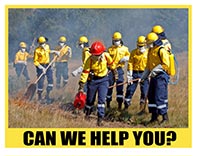Wards are the dynamic organs of Pafpa that allow it to function.
All members of the Association have input into their management and operation. Wards have the knowledge of the local conditions enabling them to make representations to the Executive Committee on the members' behalf and to make decisions regarding the issuing of permits for burning.
This association covers the Mpumalanga Escarpment area with its unique topography, vegetation and weather conditions. Click HERE to see a map of the whole Pafpa area.

Because
of the large area covered by this association and the diversity of terrain and
climate, the Platorand Fire Protection Association is divided into Wards,
Quasi Wards and affiliates, each of which is represented at Pafpa level by ward chairmen or
other delegates. The CEO of the association is the Fire Chief of Belfast local
municipality, and the chairman and the secretary are volunteers elected at the
annual general meeting.
The
Wards are formed by groups of landowners
in specific localities with particular climatic or terrain characteristics,
while the Quasi Wards and Affiliates are bodies such as local municipalities, Eskom, Transnet
and Trans Africa Concessions that have interests in the area. The areas covered
by the wards have so-called 'soft boundaries' as we are not absolutely rigid
about landowners who fall into particular areas; it is more important to us to
have them involved in the fire effort.
There is a Working on Fire Hand Crew
under the management of Thys Prinsloo, the PAFPA Fire Association
Manager, stationed in Dullstroom for the assistance of landowners in the
area.
Extract from Firewise website:
The reasons Fire Protection Associations (FPAs) Exist:
- Co-operation among rural owners and managers of land is required for the effective management of veldfires.
- The Act provides a framework for a consistent way for owners to organise and collaborate in veldfire management.
- Rural landowners need to have a collective self-sufficiency to manage veldfires because it is too costly for government to provide these services.

Advantages of registered FPAs
- Decreased risk of veldfires.
- Promotion of co-operation in managing veldfires.
- No presumption of negligence in civil claims.
- Cost saving through sharing of services.
- Advice and assistance to members from government and other services.
- Possible assistance from the Minister.
- Potential financial support from local government.
- Establishment of reasonable norms and standards for veldfire management in an area by means of FPA rules.
- Establishment of a fair and equitable basis for managing and sharing risk through an FPA's business plan.
- Powers under the Act conferred on registered fire protection officers (FPOs).
- Support from umbrella FPAs where these exist.
- Improved communication between FPA members. Improved communication between members and the Minister and other roleplayers.
- Provision of possible relief from certain prevention measures, for example, the duty to create and maintain firebreaks.
- Stronger negotiation powers by virtue of being part of an organised group.
- Possibility of reduced insurance premiums.
The beautiful grasslands in the Pafpa area look very benign in the summer when thoughts of veld fires are far from landowners' minds.

Disclaimer: Whilst every effort has been made to ensure that the information contained in this website is accurate and up to date, neither Pafpa nor its agents accept any responsibility for any errors or omissions herein
Typical grassland within the Platorand FPA area of operation. These beautiful areas become huge fire risks when they have become dormant after the winter frosts and, particularly, when the winds sweep unchecked over them:-

The Wards of Pafpa are (click on a name to open a map of the Ward in a new page):
NEDERHORST - located around the town of Dullstroom and towards the north and east;
LYDENBURG WEST - covering the lower lying parts of the association's area around the town of Lydenburg;
WATERVALSRIVIER - Northwards of Lydenburg West;
BOSCHFONTEIN - North of Oshoek and west of Watervalsrivier and Lydenburg West;
OSHOEK WARD - covering the montane areas between Nederhorst and Lydenburg;
TD7 WARD - so called because it covers Tonteldoos, Draaikraal and '7de Laan' (the Uyse Dorings road) north and north west of Dullstroom;
KRUISFONTEIN WARD - mainly along the Kruisfontein Road from the Bird of Prey Centre;
UITVLUGT WARD - along the north western side of the R540 between Dullstroom and Belfast;
KLF WARD - incorporating Komatiland Forest and its neighbours north of Belfast;
STOFFBERG WARD - West of Uitvlugt and KLF;
UITKYK WARD - West of Stoffberg, themost westerly ward;
LAKENVLEI WARD - on the south east side of the R540 opposite Uitvlugt and stretching towards Machadodorp;
WONDERFONTEIN - the areas surrounding the town and west of Belfast and towards eMalahleni;
MACHADODORP WARD - covering the area around Machado up to the other wards.
NORTHAM PLATINUM WARD -the farm known as Booysendal north of TD7 and Oshoek
SPITSKOP WARD - West of KLF, South of Stoffberg and north of Wonderfontein.
S&N TIMBERS WARD - the afforested properties that are owned and operated by S&N Timbers.
The Quasi Wards and Affiliates are:
EMAKHAZENI - covering the local municipalities of Dullstroom, Belfast and Machadodorp;
TRANSNET - in respect of the wards through which its infrastructure passes;
ESKOM - in respect of the wards in which its infrastructure is located;
TRAC N4 - for the wards through which its concession extends.